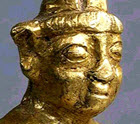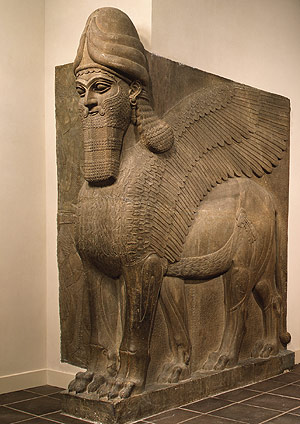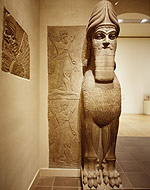Human-Headed Winged Bull
Stone Relief of a Human-Headed Winged Bull
This alabaster relief depicts the lamassu the winged bull guardian of the palace of king Ashurnasirpal of Assyria. His palace was located at ancient Kalhu (Nimrud).MET
Excerpt
Human-headed winged bull and winged lion (lamassu),
883�859 B.C.; Neo-Assyrian period, reign of Ashurnasirpal II
Excavated at Nimrud (ancient Kalhu), northern Mesopotamia
Alabaster (gypsum); H. 10 ft. 3 1/2 in. (313.7 cm)
Gift of John D. Rockefeller, Jr., 1932 (32.143.1-.2)
Description
"From the ninth to the seventh
century B.C., the kings of Assyria ruled over a vast empire centered
in northern Iraq. The great Assyrian king Ashurnasirpal II (r.
883�859 B.C.), undertook a vast building program at Nimrud, ancient
Kalhu. Until it became the capital city under Ashurnasirpal, Nimrud
had been no more than a provincial town. The new capital occupied an
area of about nine hundred acres, around which Ashurnasirpal
constructed a mudbrick wall that was 120 feet thick, 42 feet high,
and five miles long. In the southwest corner of this enclosure was
the acropolis, where the temples, palaces, and administrative
offices of the empire were located. In 879 B.C. Ashurnasirpal held a
festival for 69,574 people to celebrate the construction of the new
capital, and the event was documented by an inscription that read:
"the happy people of all the lands together with the people of Kalhu�for
ten days I feasted, wined, bathed, and honored them and sent them
back to their home in peace and joy."
The so-called Standard Inscription that ran across the surface of
most of the reliefs described Ashurnasirpal's palace: "I built
thereon [a palace with] halls of cedar, cypress, juniper, boxwood,
teak, terebinth, and tamarisk [?] as my royal dwelling and for the
enduring leisure life of my lordship." The inscription continues:
"Beasts of the mountains and the seas, which I had fashioned out of
white limestone and alabaster, I had set up in its gates. I made it
[the palace] fittingly imposing." Such limestone beasts are the
human-headed, winged bull and lion pictured here. The horned cap
attests to their divinity, and the belt signifies their power. The
sculptor gave these guardian figures five legs so that they appear
to be standing firmly when viewed from the front but striding
forward when seen from the side. These lamassu protected and
supported important doorways in Assyrian palaces" -
MET
"In the year that Tartan came unto Ashdod, (when Sargon the king of Assyria sent him,) and fought against Ashdod, and took it;" - Isaiah 20:1
Copyright � 2001 The Metropolitan Museum of Art - MET
Return to Bible History Online
Read The Bible
- 1599 Geneva Bible (GNV)
- 21st Century King James Version (KJ21)
- American Standard Version (ASV)
- Amplified Bible (AMP)
- Amplified Bible, Classic Edition (AMPC)
- Authorized (King James) Version (AKJV)
- BRG Bible (BRG)
- Christian Standard Bible (CSB)
- Common English Bible (CEB)
- Complete Jewish Bible (CJB)
- Contemporary English Version (CEV)
- Darby Translation (DARBY)
- Disciples’ Literal New Testament (DLNT)
- Douay-Rheims 1899 American Edition (DRA)
- Easy-to-Read Version (ERV)
- English Standard Version (ESV)
- English Standard Version Anglicised (ESVUK)
- Evangelical Heritage Version (EHV)
- Expanded Bible (EXB)
- GOD’S WORD Translation (GW)
- Good News Translation (GNT)
- Holman Christian Standard Bible (HCSB)
- International Children’s Bible (ICB)
- International Standard Version (ISV)
- J.B. Phillips New Testament (PHILLIPS)
- Jubilee Bible 2000 (JUB)
- King James Version (KJV)
- Lexham English Bible (LEB)
- Living Bible (TLB)
- Modern English Version (MEV)
- Mounce Reverse Interlinear New Testament (MOUNCE)
- Names of God Bible (NOG)
- New American Bible (Revised Edition) (NABRE)
- New American Standard Bible (NASB)
- New American Standard Bible 1995 (NASB1995)
- New Catholic Bible (NCB)
- New Century Version (NCV)
- New English Translation (NET)
- New International Reader's Version (NIRV)
- New International Version - UK (NIVUK)
- New International Version (NIV)
- New King James Version (NKJV)
- New Life Version (NLV)
- New Living Translation (NLT)
- New Matthew Bible (NMB)
- New Revised Standard Version (NRSV)
- New Revised Standard Version Catholic Edition (NRSVCE)
- New Revised Standard Version, Anglicised (NRSVA)
- New Revised Standard Version, Anglicised Catholic Edition (NRSVACE)
- New Testament for Everyone (NTE)
- Orthodox Jewish Bible (OJB)
- Revised Geneva Translation (RGT)
- Revised Standard Version (RSV)
- Revised Standard Version Catholic Edition (RSVCE)
- The Message (MSG)
- The Voice (VOICE)
- Tree of Life Version (TLV)
- World English Bible (WEB)
- Worldwide English (New Testament) (WE)
- Wycliffe Bible (WYC)
- Young's Literal Translation (YLT)
Table of Contents

Ancient Near East Art
- Female Worshipper- Uruk
- Funerary Head of an Elamite
- Stele of Mesha, King of Moab
- Sarcophagus of Eshmunazor II, king of Sidon
- Stele Showing the Storm-God Baal
- Fertility Goddess - Ugarit
- Oskoron I - Byblos
- The Spinner Relief
- The Archers of Darius
- Bull Capital From Darius I Palace
- Sargon II and a High Official
- Tablet of Sargon's 8th Campaign
- Winged Assyrian Bulls
- Law-Codex of Hammurabi
- Hero Choking a Small Lion
- Kudurru of Melishihu
- Hittite God - Gold Figurine
- Seated Statue of Gudea, prince of Lagash
- Foundation Nail Of Ur Ba'u
- Cylinder-Seal Of Sharkalisharri
- Victory Stele of Naram-Sin
- Urnanshe (King of Lagash) Relief
- Ebih-II, the Superintendent of Mari
- Tablet Of Pre-Cuneiform Script
- King and Eunuch Attendant Relief
- Human-Headed Winged Bull
- Bearded Man Holding Tendrils
- Nubian With Animals and Skins
- Head of a Roaring Lion
- Cylinder Seal With Impression
- Orthostat Relief - Hunting Scene
- Sphinx Plaques
- Throne With Bull Deity
Ancient Egypt
- Model of a Riverboat
- Ritual Figure of the 12th Dynasty
- Stela of Mentuwoser
- Coffin of Khnum-nakht
- Sphinx of Senwosret III
- Face of Senwosret III
- Pectoral with the Name of Senwosret II
- Cat
- Statuette of a Hippopotamus
- Seated Statue of Hatshepsut
- Ostracon of Senenmut
- Chair of Renyseneb
- Heart Scarab of Hatnofer
- Kneeling Statue of Tuthmosis III
- Arm Panel from a Ceremonial Chair
- Sphinx of Amenhotep III
Mediterranean
Main Menu
- Ancient Assyrian Social Structure
- Ancient Babylonia
- Ancient Canaan During the Time of Joshua
- Ancient History Timeline
- Ancient Oil Lamps
- Antonia Fortress
- Archaeology of Ancient Assyria
- Assyria and Bible Prophecy
- Augustus Caesar
- Background Bible Study
- Bible
- Biblical Geography
- Fallen Empires - Archaeological Discoveries and the Bible
- First Century Jerusalem
- Glossary of Latin Words
- Herod Agrippa I
- Herod Antipas
- Herod the Great
- Herod's Temple
- High Priest's in New Testament Times
- Jewish Literature in New Testament Times
- Library collection
- Map of David's Kingdom
- Map of the Divided Kingdom - Israel and Judah
- Map of the Ministry of Jesus
- Matthew Henry Bible Commentary
- Messianic Prophecy
- Nero Caesar Emperor
- Online Bible Maps
- Paul's First Missionary Journey
- Paul's Second Missionary Journey
- Paul's Third Missionary Journey
- Pontius Pilate
- Questions About the Ancient World
- Tabernacle of Ancient Israel
- Tax Collectors in New Testament Times
- The Babylonian Captivity
- The Black Obelisk of Shalmaneser
- The Books of the New Testament
- The Court of the Gentiles
- The Court of the Women in the Temple
- The Destruction of Israel
- The Fall of Judah with Map
- The History Of Rome
- The Incredible Bible
- The Jewish Calendar in Ancient Hebrew History
- The Life of Jesus in Chronological Order
- The Life of Jesus in Harmony
- The Names of God
- The New Testament
- The Old Testament
- The Passion of the Christ
- The Pharisees
- The Sacred Year of Israel in New Testament Times
- The Samaritans
- The Scribes
Ancient Questions
- Why Do the Huldah Gates Appear Different in Ancient Replicas and Modern Photos?
- What Is the Origin of the Japanese and Chinese Peoples? A Biblical Perspective
- How did the ancient Greeks and Romans practice medicine and treat illnesses?
- What were the major contributions of ancient Babylon to mathematics and astronomy?
- How did the ancient Persians create and administer their vast empire?
- What were the cultural and artistic achievements of ancient India, particularly during the Gupta Empire?
- How did ancient civilizations like the Incas and Aztecs build their remarkable cities and structures?
- What were the major trade routes and trading practices of the ancient world?
- What was the role of slavery in ancient societies like Rome and Greece?
- How did the ancient Mayans develop their sophisticated calendar system?
Bible Study Questions
- Why Do Christians Celebrate Christmas?
- How Many Chapters Are There in the Bible?
- The Five Key Visions in the New Testament
- The 400-Year Prophecy: Unpacking Genesis 15 and the Journey of a People
- The Authorized (King James) Version (AKJV): Historical Significance, Translation Methodology, and Lasting Impact
- Exploring the English Standard Version (ESV): Its Aspects, Comparisons, Impact on Biblical Studies, and Church Use
- A Detailed Historical Analysis of Language Updates in the KJ21: Comparison with Other Versions
- A Detailed Historical Analysis of the American Standard Version (ASV): Comparison to the King James Version, Influence on Later Translations, and Evaluation of Strengths and Weaknesses
- A Detailed Historical Analysis of Amplifications in the Amplified Bible (AMP) and Its Comparison to Other Bible Translations
- Detailed Historical Analysis of the Amplified Bible Classic Edition (AMPC): Examples of Amplifications and Comparative Analysis with Other Bible Translations
About
Welcome to Free Bible: Unearthing the Past, Illuminating the Present! Step into a world where ancient history and biblical narratives intertwine, inviting you to explore the rich tapestry of human civilization.
Discover the captivating stories of forgotten empires, delve into the customs and cultures of our ancestors, and witness the remarkable findings unearthed by dedicated archaeologists.
Immerse yourself in a treasure trove of knowledge, where the past comes alive and illuminates our understanding of the present.
Join us on this extraordinary journey through time, where curiosity is rewarded and ancient mysteries await your exploration.
Recent posts
-

A Strategic Overview of Shipping Pets to Europe: Navigating EU Regulations from a Global Perspective
The term "shipping pets to Europe" encompasses the complex, regulated process of moving a companion animal from a non-EU country into the European Uni... -

How Philips Zoom Handpiece Limitations Impact Clinic Profitability — And How to Break the Cycle
For most dental and aesthetic clinics, professional whitening is expected to be one of the highest-margin services. Patients are willing to pay premiu... -

Do Scientists Believe in God? Faith and Science in the 21st Century
For centuries, people have debated whether science and faith can go hand in hand. Some argue that science should rely only on what can be measured and... -

Listening Deeper: Ekaterina Fakhrutdinova on How Soul Care Becomes a New Culture of Care
Author: Susan Perk Date: 24 Sep 2025 When faith is not dogma, but dialogue. And when psychology is not diagnosis, but service. Today, Christian psycho... -

The Vital Role of Christian Translation Ministries in Spreading the Gospel
The Gospel is for every tribe, tongue, and nation. Yet, millions of people around the world still cannot access Scripture in their own language. This ...


